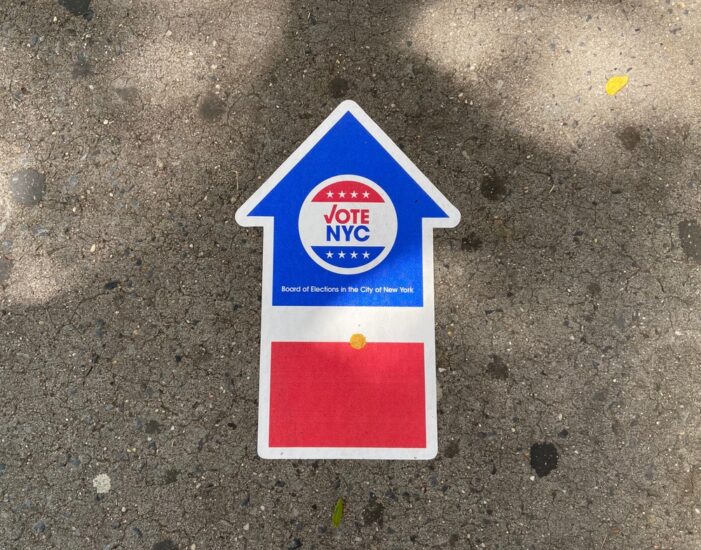By Linda Nwoke
Editorial credit: Here Now / Shutterstock.com
New York City conducted the first ranked-choice voting on February 2, 2021. The City employed the voting system during Council District 24’s special municipal election in Queens. Again, at the primary elections for the city council members, public advocate, borough president, comptroller, and mayoral elections. The last two election cycles since 2019 used this method. It was the year of approval for the voting method for all Special Elections after January 1, 2021.Elections for the country’s President, Governor, and Senate are not subject to ranked-choice voting as this applies just to NYC elections and other select states at this time.
Under ranked-choice voting, voters can order as many as five candidates in order of preference or choose to select only one candidate as their first choice. Suppose no candidate receives a majority of first-choice votes. In that case, there is an elimination of the person with the lowest number of votes, and the redistributed to the remaining candidates based on the participants’ second choice. The process will continue until a candidate receives a majority of the votes.
Interestingly in just two years, the relatively new voting system has gradually gained acceptance despite initial pushback by several entities.
Initially, New Yorkers raised numerous concerns about implementing the voting system in New York City. One of the main concerns was the possibility of creating confusion among voters. However, the New York City Board of Elections took steps to educate voters about the new system, including sending out instructional materials and holding information sessions. Furthermore, they also developed a website and hotline where voters could gather more information and assistance. Another concern was the possibility of promoting negative campaigning as candidates sought to undermine their opponents’ support, but research findings proved this wrong.
Value of Ranked Choice Voting (RVC)
The voting process is quite valuable. It allows voters to rate their candidate in order of preference instead of simply selecting one, increasing the chances of more diverse and representative candidates. Under the traditional voting system, popular candidates with a narrow edge in the electorate can win elections even if they are not the preferred candidate of the majority.
Secondly, the process encourages robust and civil campaigning by candidates to appeal to a broader range of voters to win. Implicitly, some candidates considered non-viable under the traditional system, such as candidates of color or with unconventional platforms, have a better chance of winning.
Moreover, in the New York City elections, there were fewer attack advertisements and more positive messaging than in previous elections. Unlike previous traditional elections, it also reduced the need for time-consuming and expensive runoff elections. When there is no candidate with a majority of the votes, they sometimes conduct a runoff election between the two leading candidates with the most votes. The runoff polls can be expensive and time-consuming, resulting in lower voter turnout. With ranked-choice voting, there is no need for a runoff election to redistribute the votes to the highest-polling candidate who receives the most votes.
Challenges to Ranked Choice Voting
Overall, ranked-choice voting in New York City has been successful despite initial concerns about the possibility of negative campaigning and confusion. Evidence shows that all the elections conducted with the process have been smooth and civil.
Although the process encountered some technical issues during the vote-counting process, most were quickly resolved. The process has supported the primary goal of any democratic system by allowing the participation of more diverse and representative candidates, significantly often marginalized groups.
Despite the primarily positive result, there are still some challenges to increasing the effectiveness of ranked-choice voting, such as increasing voter education and diverse candidacy.
On the issue of inadequate voter education, while the Board of Elections succeeded in educating voters about the new system, some voters needed clarification, and others needed to understand how to rank their choices fully. This challenge requires more education and outreach to ensure all voters are fully informed about voting.
Hence in collaboration with RankedVote, the Civic Engagement Commission (CEC) has launched a multilingual, interactive online app like the NYC ballot. It aims at helping New Yorkers better understand how RCV works before they go to the polls.
The interactive ballot is in at least 15 languages like Chinese, Spanish, Bengali, Polish, Yiddish, Greek, Haitian Creole, Russian, Korean, Urdu, Polish, French, Arabic, Italian, Albanian, and Hindi has spoken by eligible voters who do not speak English as their first language and have low proficiency.
The team works directly with community-based organizations to distribute customizable ballots in different languages. Additionally, there is a need for more diverse and representative candidates to participate. While the process can help promote diversity, it is not an automatic solution. Other systemic challenges include structural difficulties in running for office and money’s political influence.
Using Ranked Choice Voting (RCV) in the 2023 Election
On June 27, 2023, the RCV, often used for municipal elections and non-state offices, will be employed for the district attorney races. Thus, District Attorneys will be on the ballot for voters in three boroughs- Queens, the Bronx, and Staten Island.
Critical Facts about Ranked Choice Voting
Generally, voters rank up to five candidates in each race instead of the traditional act of choosing only one favorite candidate.
The candidate that gets more than 50% of the first-place votes wins. However, if no candidate reaches that majority, the ranked-choice method sorts out the best-preferred candidate by a majority, canceling a runoff election between the top two vote-getters.
Additionally, eliminated candidates based on the fewest first-choice votes are removed from the race. The voters’ second-choice picks are counted and continue, with one candidate removed on each round until the identification of a candidate with more than half of the first-place votes.
While a voter can choose up to five candidates, it is not required. Furthermore, only the first ranking will count if a voter ranks their preferred candidate more than once. After eliminating the top-choice candidate, the vote will count toward the next highest-rated candidate.
Key Effects of Ranked Choice Voting in New York City’s Politics
Overall, the system of RCV favors popular candidates supported by the electorate, as evidenced in New York City’s political landscape. Although complicated, the voting system allows voters to select candidates representing their preferences more precisely than previous first-to-make-it ballots. Instead, it supports the candidate who will obtain more than half the total vote.
In addition, it contributed significantly to a decrease in the chances of negative campaigns and wasteful use of resources to conduct rerun elections.
The last city elections also witnessed an increase in diverse participation, especially of more women and women of color, thus ensuring that the elected officials are more representative of their communities and a true reflection of the City’s true nature.
Ultimately, voters must remember that the system allows them to choose whom they want to win through ranking. When a voter ranks multiple candidates, they can still support the election of their preferred candidate, even if their top choice fails.
Ranking multiple candidates ensures that one’s vote will go toward other candidates upon eliminating their top choice, giving you more say in determining the ultimate winner.





